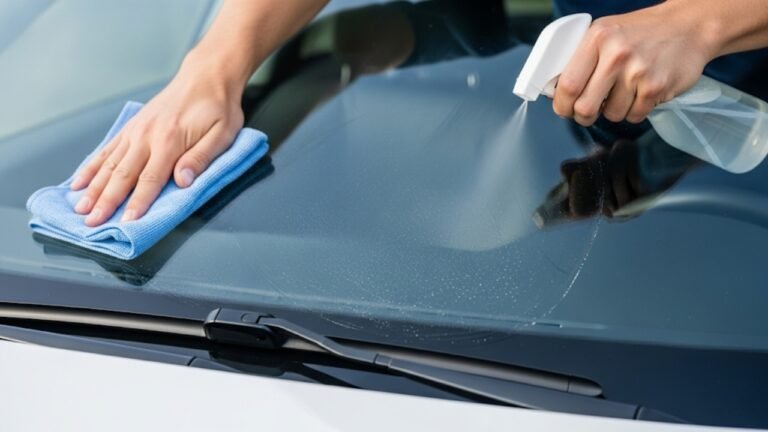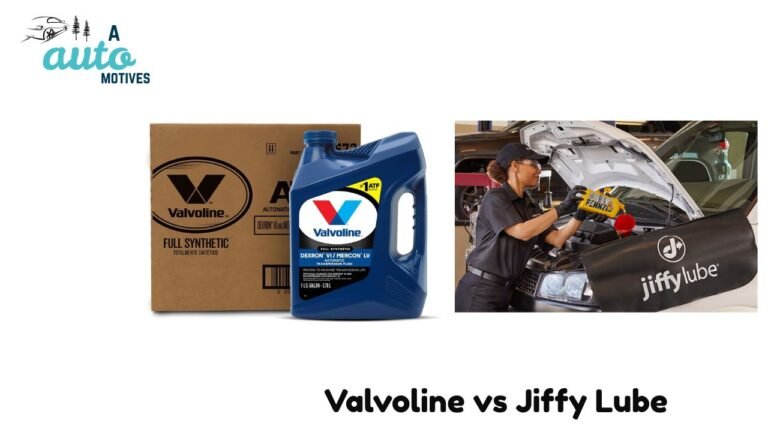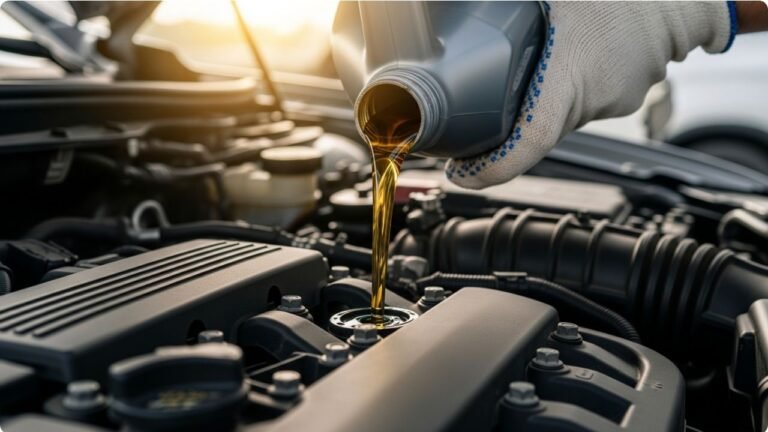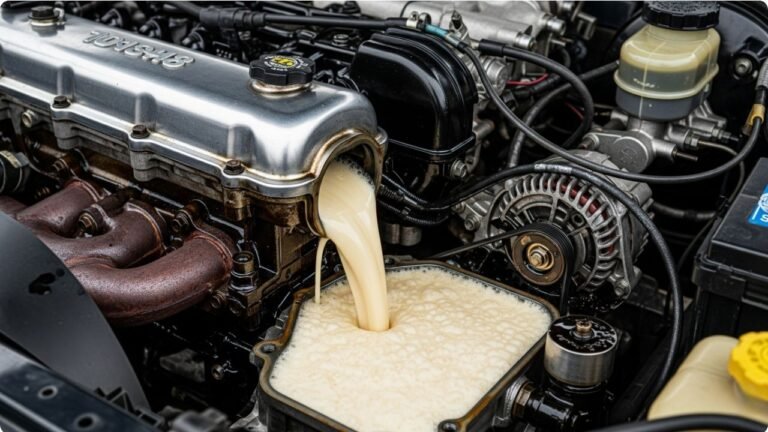Can You Put Oil in Your Car When the Engine Is Hot?

We’ve all been there. You’re heading somewhere important. Maybe you’re driving to your cousin’s wedding in the middle of summer or just doing a quick grocery run, and suddenly—you see the engine oil light blink at you. Panic. Do you pull over and top off the oil immediately? Or do you wait for the engine to cool down?
The question that usually pops up in that moment is:
“Can you put oil in your car when the engine is hot?”
The short answer? Yes, but with caution.
In this guide, we’ll dive into everything you need to know about adding oil to a hot engine—what’s safe, what’s risky, and how you can make the best choice for your car (and your wallet). We’ll walk you through real experiences, mechanical insights, and give you some emotional peace of mind. Because your car deserves love, just like anything else you rely on every day.
In This Article
- 1 Why Engine Oil Matters More Than You Think
- 2 Is It Safe to Add Oil When the Engine Is Hot?
- 3 A Relatable Story: My First Time Topping Oil on a Hot Engine
- 4 What Happens If You Wait Too Long to Add Oil?
- 5 Step-by-Step: How to Safely Add Oil to a Hot Engine
- 6 Comparing Engine States for Oil Top-Up
- 7 Common Myths About Adding Oil to a Hot Engine
- 8 Pros and Cons of Adding Oil to a Hot Engine
- 9 Things to Keep in Your Trunk
- 10 How Engine Oil Reacts to Heat: The Science in Simple Terms
- 11 Understanding Viscosity: Why It Matters in Hot Engines
- 12 What If You Overfill Oil by Mistake?
- 13 Cultural Insight: Car Habits Around the World
- 14 Signs Your Engine Is Crying for Oil (Even If It’s Hot)
- 15 FAQs: Quick Answers to Common Questions
- 15.1 1. Can you check your oil when the engine is hot?
- 15.2 2. Can you add oil while the engine is running?
- 15.3 3. Is it better to add oil to a cold or warm engine?
- 15.4 4. Will adding oil fix engine knocking?
- 15.5 5. How often should I check my oil?
- 15.6 6. Can I mix different oil brands or types?
- 15.7 7. What’s the best oil for hot climates?
- 15.8 8. Can too much oil damage the engine?
- 16 Emotional Wrap-Up: Listen to Your Engine Like a Friend
- 17 Final Checklist: Do’s and Don’ts
- 18 Final Thoughts: Be Prepared, Not Panicked
Why Engine Oil Matters More Than You Think
Think of engine oil as your car’s blood. Without it, things grind, burn, and break. The oil lubricates engine parts, keeps things cool, and removes grime and particles. That tiny oil can warning light? It’s basically your car saying, “Hey! I’m thirsty.”
Driving with low oil can:
-
Increase engine wear
-
Cause overheating
-
Lead to complete engine failure
Now, imagine trying to run a marathon without water. That’s your engine without oil.
So yes—topping up oil when needed is absolutely crucial, even if your engine is warm or hot.
Is It Safe to Add Oil When the Engine Is Hot?
Here’s the big one: Can you put oil in your car when the engine is hot?
Yes, you can add oil to a hot engine, but be cautious. Car engines are designed to handle oil at high temperatures, but your safety—and accuracy—matter.
Here’s what you need to know:
When It’s Safe to Add Oil to a Hot Engine
-
If the engine is warm or recently shut off, it’s fine.
-
Modern synthetic oils are designed to perform under heat.
-
Your oil cap and dipstick are made to withstand high temps.
What You Should Avoid
-
Don’t pour cold oil into a superheated engine block right after driving 100km at high speed.
-
Avoid touching metal parts—they can burn your hand.
-
Don’t overfill the oil—it can lead to frothing, leaks, and pressure issues.
In simpler terms: if you’ve just parked and your engine is warm but not boiling, go ahead—add the oil. Just do it slowly and carefully.
A Relatable Story: My First Time Topping Oil on a Hot Engine
Let me tell you a story.
One summer in Mymensingh, I was driving home from cricket practice. It was sweltering, and I had this old Toyota Corolla. I noticed the oil light flickering and panicked. Pulled over at a roadside stall, bought a bottle of oil, and popped the hood.
The engine was hot enough to fry an egg.
But I waited a few minutes, gently unscrewed the oil cap (using a piece of cloth), and slowly added oil. Nothing exploded. No drama. The engine purred happily after.
That was the day I realized: with a little care, you can top off oil in a hot engine.
What Happens If You Wait Too Long to Add Oil?
Delaying oil top-ups can be worse than adding oil to a warm engine.
Letting your car run with low or no oil leads to:
-
Friction damage between engine parts
-
Overheating, especially in summer or traffic
-
Oil sludge buildup, reducing efficiency
-
Catastrophic engine failure (yes, it’s that serious)
If your oil level is below the minimum, waiting too long may cost you a new engine, or worse, the car itself.
So, the question isn’t just “can you put oil in your car when the engine is hot?” It’s also:
“Can you afford not to?”
Step-by-Step: How to Safely Add Oil to a Hot Engine
Adding oil is simple, but a few steps make it safer when the engine is warm or hot.
Here’s What to Do:
-
Park on a flat surface and turn off the engine.
-
Wait 5–10 minutes to let it cool slightly.
-
Pop the hood and locate the oil cap.
-
Use a cloth or glove if it feels hot.
-
Check the dipstick to see current oil level.
-
Slowly add small amounts of oil at a time.
-
Re-check dipstick to avoid overfilling.
-
Replace cap securely.
Tip: Always use the recommended oil type for your car. Check the manual or cap for details.
Comparing Engine States for Oil Top-Up
| Engine Temperature | Can You Add Oil? | Recommended Wait Time | Safety Tip |
|---|---|---|---|
| Cold (Overnight) | Yes | None | Safe & Ideal |
| Warm (Recently Off) | Yes | 5–10 Minutes | Use cloth for cap |
| Hot (Just Parked) | Yes, Carefully | 10–15 Minutes | Avoid spills & burns |
| Overheating | No | Wait until cool | Call mechanic |
This shows that the warmer the engine, the more cautious you need to be—but you don’t have to wait hours.
Common Myths About Adding Oil to a Hot Engine
Let’s bust some myths floating around online and in garage gossip.
Myth #1: You Should Never Add Oil to a Hot Engine
Wrong. You can, just not when it’s overheating or boiling hot.
Myth #2: Oil Will Catch Fire If Poured Into a Hot Engine
Not true. Engine oil has a high flash point, and your engine isn’t hot enough to ignite it.
Myth #3: It’s Better to Wait Hours Before Checking or Topping Off Oil
While it’s ideal to check oil on a cold engine for accuracy, topping off when needed matters more.
Pros and Cons of Adding Oil to a Hot Engine
Let’s break it down further.
Pros
-
Immediate protection from damage
-
Prevents oil starvation
-
Keeps engine running smoothly
Cons
-
Risk of burns if not careful
-
Oil measurement might be slightly off
-
Potential for overfill if you don’t recheck later
Still, the benefits outweigh the risks—if you do it properly.
Things to Keep in Your Trunk
To stay safe and ready, here’s a quick kit you can keep in your trunk:
-
1L bottle of your car’s recommended oil
-
Microfiber cloth or old towel
-
Disposable gloves
-
Small funnel (plastic or silicone)
-
Flashlight (for night emergencies)
Trust me, this kit has saved me more than once—especially during long trips on the Dhaka-Mymensingh highway.
How Engine Oil Reacts to Heat: The Science in Simple Terms
Imagine you’re heating water. It gets thinner and moves faster. Oil does something similar.
When your engine heats up, the oil thins out. This makes it flow more easily to lubricate all the moving parts. But here’s the catch: too much heat over time breaks the oil down, reducing its effectiveness.
That’s why regular oil checks are essential. Overheating doesn’t just affect the engine—it affects the oil itself.
What Happens to Oil When It Gets Too Hot?
-
Loses viscosity (becomes too thin)
-
Fails to lubricate properly
-
Forms sludge and carbon buildup
-
Starts to oxidize and break down chemically
And guess what? That’s when engine wear begins, especially if you ignore the low oil light.
Understanding Viscosity: Why It Matters in Hot Engines
Let’s decode a common confusion: viscosity.
Viscosity is a fancy word for how thick or thin your oil is. The numbers on oil containers—like 10W-30 or 5W-20—tell you about that.
-
The first number with a “W” (winter) is how it flows when cold.
-
The second number is how it behaves when the engine is hot.
If your car runs hot often, especially in warm climates like Bangladesh or Florida, a slightly higher viscosity oil might be better. It stays thicker even when hot, giving better protection.
But remember—always follow what your car’s manual recommends.
What If You Overfill Oil by Mistake?
So you’ve added oil to a hot engine. But maybe you poured a little too much. Now what?
Overfilling your engine oil can be just as bad as running low. It causes the oil to foam, lose lubrication quality, and might even damage seals or your catalytic converter.
Symptoms of Overfilled Oil:
-
White or bluish smoke from the exhaust
-
Rough idling or poor acceleration
-
Burning oil smell
-
Oil leaking from the engine
What To Do If You Overfill:
-
Use a manual pump or turkey baster to extract some
-
Visit a mechanic if unsure
-
Always recheck the dipstick after adding oil
Being careful while pouring—especially into a warm engine—is the key to avoiding this mess.
Cultural Insight: Car Habits Around the World
It’s interesting how car care habits differ worldwide.
In rural parts of Bangladesh, it’s not uncommon to see someone topping off engine oil at a tea stall while sipping cha. In contrast, in places like Germany, people obsessively measure oil levels when the engine is ice-cold for maximum precision.
Both styles work, as long as you know your car. And sometimes, your intuition and listening to the engine can matter just as much as the dipstick reading.
That blend of mechanical understanding and human instinct is what makes us good drivers—not just good car owners.
Signs Your Engine Is Crying for Oil (Even If It’s Hot)
It’s not always about the oil light. Your car might whisper before it screams.
Watch for These Signs:
-
Ticking noises when starting or idling
-
A burning smell from the engine bay
-
Oil spots on the driveway
-
Decrease in fuel efficiency
-
Engine running hotter than usual
If any of these show up—check your oil, no matter the engine temperature. A little bottle of oil can prevent a lot of heartache.
FAQs: Quick Answers to Common Questions
1. Can you check your oil when the engine is hot?
Yes, but the reading may not be 100% accurate. Wait 5–10 minutes after shutting the engine off for better accuracy.
2. Can you add oil while the engine is running?
No. Always turn off the engine before opening the oil cap. It’s safer, and you’ll avoid splashes or burns.
3. Is it better to add oil to a cold or warm engine?
Technically, cold engines give more accurate readings, but adding oil to a warm engine is perfectly safe if done carefully.
4. Will adding oil fix engine knocking?
If knocking is due to low oil, then yes, adding oil may fix it. But if the damage is already done, you’ll need a mechanic.
5. How often should I check my oil?
At least once a month—or every two weeks if you drive long distances or in extreme weather.
6. Can I mix different oil brands or types?
You can mix same-grade synthetic oils in a pinch, but it’s better to stick to one brand and type for consistency.
7. What’s the best oil for hot climates?
Higher viscosity oils (like 10W-40) are often better in hot climates, but always follow your manufacturer’s guide.
8. Can too much oil damage the engine?
Yes. Overfilling leads to pressure buildup, seal leaks, and poor performance.
Emotional Wrap-Up: Listen to Your Engine Like a Friend
Your car doesn’t speak your language, but it communicates—through lights, sounds, smells, and sensations. When you learn to listen, you develop a bond with it, like you do with a friend or pet.
So next time you wonder, “Can you put oil in your car when the engine is hot?”—remember this:
- Yes, you can.
- Just do it with care.
- Be smart.
- And most of all—treat your engine with love.
Final Checklist: Do’s and Don’ts
DO:
-
Wait 5–15 mins before adding oil to a hot engine.
-
Use a funnel to avoid spills.
-
Check dipstick before and after.
-
Wear gloves or use a cloth if surfaces are hot.
-
Keep a bottle of oil in your trunk.
DON’T:
-
Open the oil cap while the engine is running.
-
Pour oil too quickly into a very hot engine.
-
Overfill beyond the max dipstick line.
-
Ignore warning lights.
-
Use the wrong type of oil.
Final Thoughts: Be Prepared, Not Panicked
The road can be unpredictable, but your response doesn’t have to be. Being prepared with knowledge (and a spare bottle of oil) can make the difference between a quick fix and a major breakdown.
So yes—you can put oil in your car when the engine is hot, as long as you respect the heat, the mechanics, and your own instincts.
Whether you’re a daily commuter, a weekend road-tripper, or a first-time driver trying to figure it all out—you’ve got this. Your engine is counting on you.
Stay safe, stay curious, and may your dipstick always read “full.”






